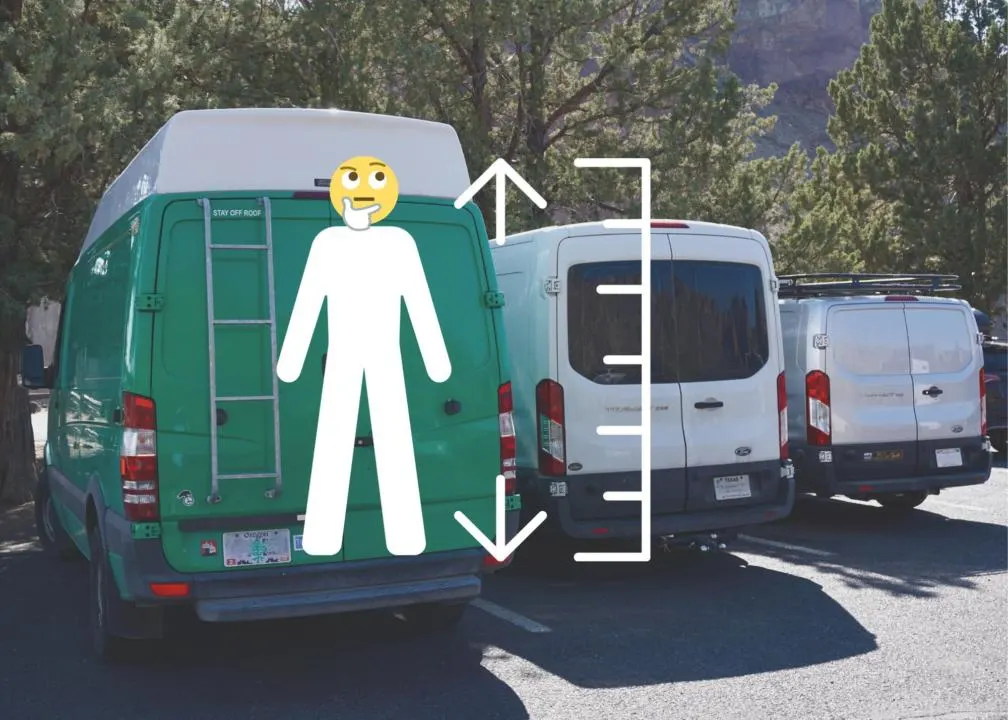
When searching for vans, most people want to know “what vans can you stand up in?”. Choosing a van that is tall enough to stand makes a huge difference on the overall comfort and liveability of your campervan. Especially for full-time vanlife, it is a huge benefit not to be hunched over all the time, and it also means more interior space for furniture and personal items. This list breaks down all the tallest vans in the US market that you can stand up in.
Note: A fully converted van will typically use up about 2-4 inches of interior height for flooring, ceiling, and insulation. So to properly stand up in your finished van, you should plan for about 3-6 inches of “wiggle room.” This accounts for the height lost to conversion materials and also gives you some clearance between your head and the ceiling. That way you have extra space if you are wearing shoes, or a hat, or you decide to rock a mohawk. Okay, you might actually need a little more space for that.
Ford Transit Van
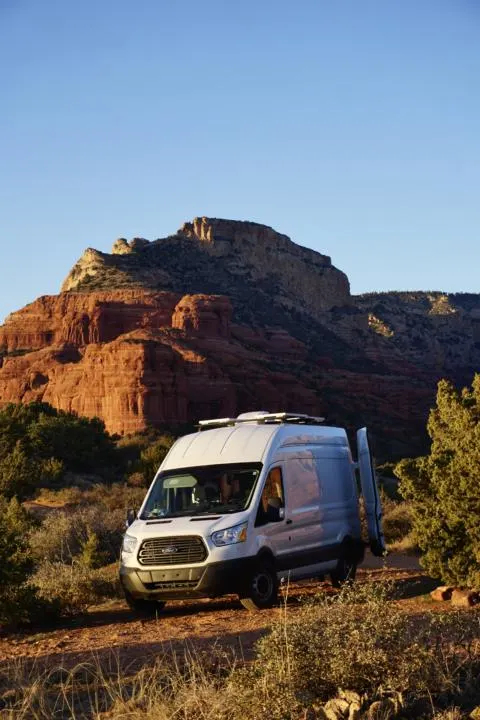
High Roof: 81.5 inches (207 cm)
Mid Roof: 72 inches (182.9 cm)
Low Roof: 56.9 inches (144.5 cm)
The Ford Transit high-roof is the tallest interior height van in production. At an impressive 81.5 inches, a converted high-roof Transit can accommodate someone up to about 6’7″ tall. The Ford Transit also comes in two other roof heights; low and mid. The low-roof is much too short for most people, but the mid-roof can even be tall enough for shorter people to stand up in. A converted mid-roof Transit can fit people 5’9′ and shorter.
The Ford Transit is a popular choice for van conversions because they are a more affordable alternative to the Mercedes Sprinter. {Read: How Much Does It Cost To Convert A Campervan}. They are easier and cheaper to maintain in the US. Beginning in 2021, there is an AWD option. Otherwise, they are rear-wheel-drive, which is preferable for off-road driving and heavy-load carrying.
Mercedes Sprinter Van (2018 to present)

High Roof: 79.1 inches (200.9 cm)
Standard Roof: 67.7 inches (172 cm)
The Mercedes Sprinter Van comes in with the second tallest factory option of vans you can stand up in. Their high-roof model (once converted) can accommodate someone up to about 6’4″ tall. The only other roof height option is the standard roof, which can only fit someone up to 5’5″ tall.
Mercedes Sprinter is well-known as the luxury option of campervans. They have many optional premium features and trim options. And they are the only van available with a 4×4 option from the factory (otherwise, they are RWD).
RAM Promaster Van
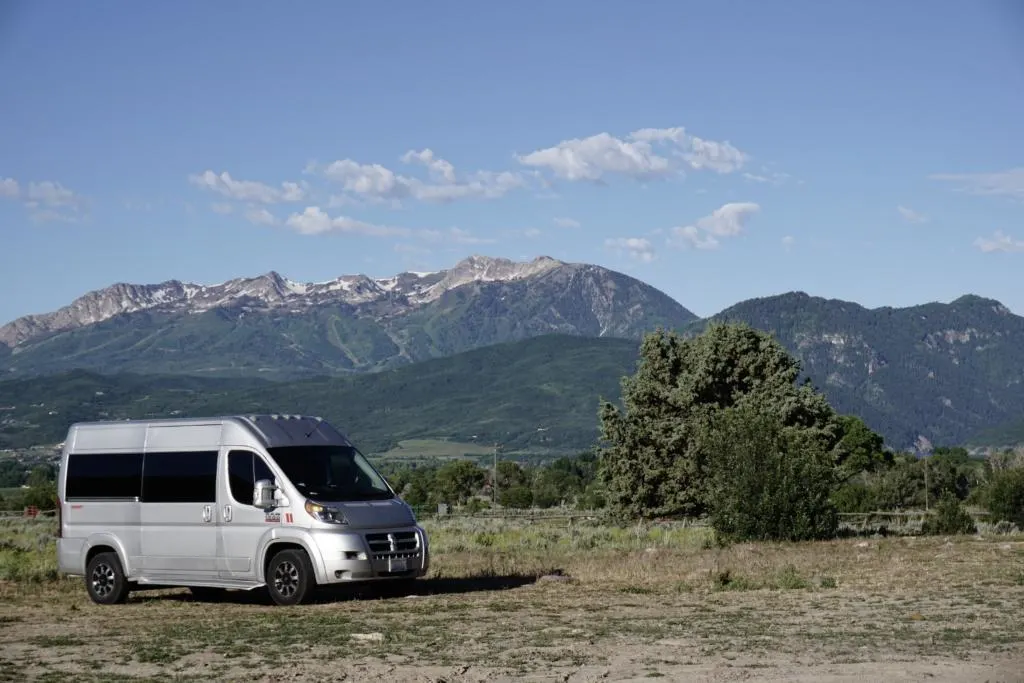
High Roof: 76 inches (193 cm)
Regular Roof: 65.4 inches (166 cm)
The RAM Promaster is another popular van choice that you can stand up in. A converted high-roof Promaster can accommodate anyone up to about 6’1″ tall. And only about 5″2 for the regular roof models.
The RAM Promaster is another more affordable alternative to the Mercedes Sprinter. And while it may not be the tallest, the Promaster is the widest of all vans. Which allows for a queen bed to be installed sideways without modifications, thus making significant gains in living space. {Read: Can You Sleep Sideways In a Van?}
RAM Promaster is only made with front-wheel-drive, which is less ideal for off-road driving, especially climbing steep grades.
Nissan NV Van
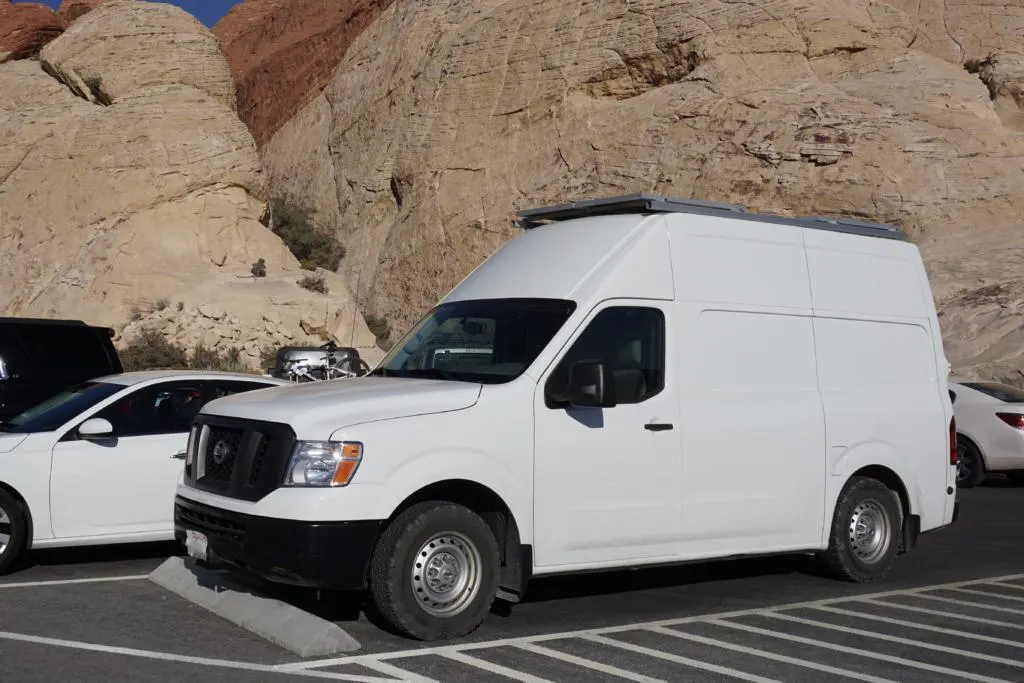
High Roof: 76.9 inches (195 cm)
Low Roof: 42 inches (106.7 cm)
The Nissan NV (discontinued) is available in a high-roof option that can accommodate someone up to 6’2″ tall. And the low roof is too short for nearly anyone to stand up in. The Nissan NV has a long hood, like a truck, and that results in less overall space for cargo. Their interior lengths are much shorter than the competition, and its probably why they weren’t able to grab enough market share to survive. They do however have the most towing capacity of any van.
Pop-Top Camper Vans
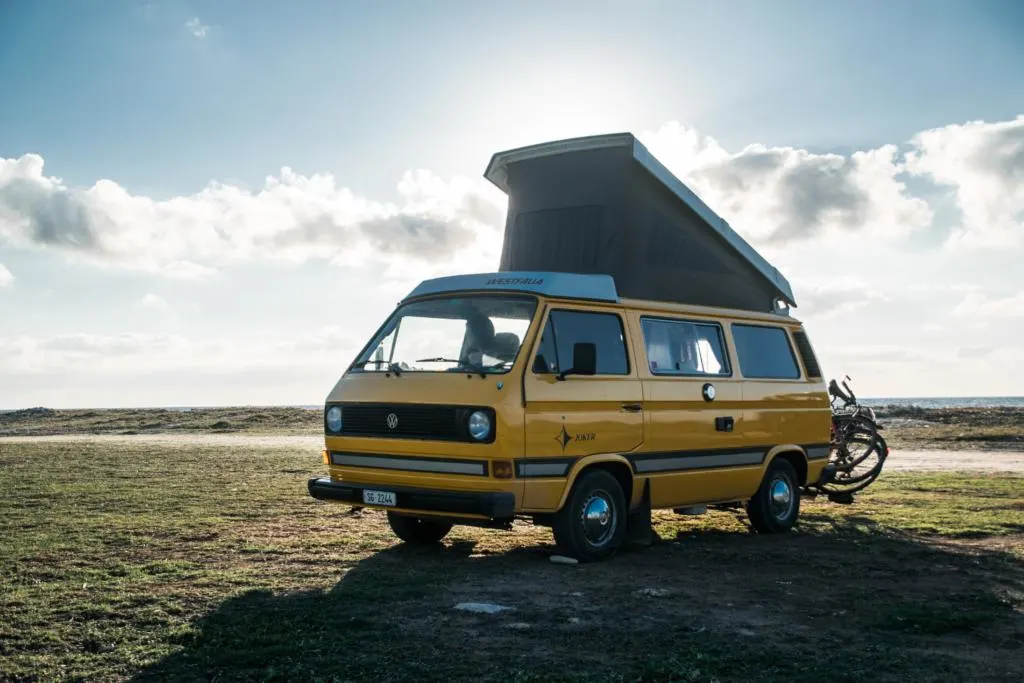
Interior Height: Adds about 12-36”
The interior height of pop-top campervans varies greatly. It depends on the roof height of the original vehicle, and the height added by the pop-top. But typically they are added to low-roof vans, which begin with an interior height of around 50-60”. So then the pop-top can bring the interior height up to around 65”-95” tall.
Some pop-tops pop up at an angle, and some pop up parallel to the ground. And pop-tops also limit how much weight you can attach to the roof (solar panels, roof racks, etc).
There are several benefits of pop-top campervans. They can be more affordable than a high-roof van conversion. They allow your van to drive like a low-roof vehicle, but camp like a high-roof. This allows you to fit in parking garages, drive-thrus, etc.
The major drawback of pop-top campervans is that the material of the pop-top isn’t as rugged as the metal walls of a van. It is like pseudo-tent-camping. Wind, weather, and noise will be more noticeable than being inside a hard-sided campervan.
And the other negative is that pop-tops are more narrow than the overall width of the roof, so that they can nest inside. And many vans curve inward already at the roof, so the width of a pop-top is typically significantly less wide than the widest point of the van.
A few well-known companies that specialize in pop-top campervans are: Sportsmobile, Modvans, Winnebago, Roadtrek, Pleasure Way, Colorado Camper Van, and Westfalia.
Fiberglass Hightop Vans
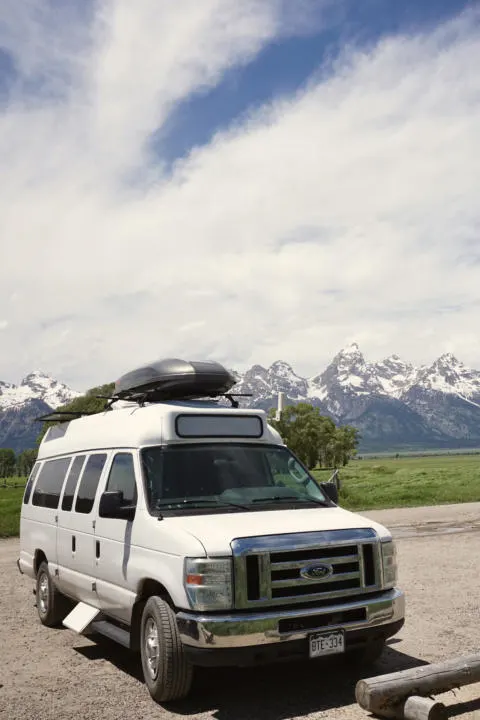
Interior Height: 60 to 90 inches
Fiberglass hightops are an aftermarket customization that can be added to any van. But they are more common on older vans that traditionally didn’t come with a factory high-roof option. They are somewhat rare, but represent good value if you can find one. In the US, this category is most commonly made up of conversion vans, ambulances, shuttle vans, handicap vans, and custom campervans. It is possible to purchase a low-roof van, and add your own hightop. A company called Fiberine in Long Beach, California is one of the most well-known installers of fiberglass hightops. But be prepared to fork over a few thousand dollars.
Or, I have seen a few ambitious folks DIY their own fiberglass or wooden hightops. But this isn’t a task I would recommend for your average DIYer.
Be aware that the overall interior height varies greatly based on the size of the fiberglass hightop. If you find a used one for sale, ask the seller about the interior height, or investigate for yourself. And be aware that the van’s current conversion may have flooring, ceiling, insulation, etc may be altering the interior height. Our converted fiberglass hightop campervan is only about 5’9” tall inside, and I’m 5’8” so it’s just barely tall enough for me.
I have written extensively about fiberglass hightop vans, since that’s the type of van we live in. Why Choose A Fiberglass Hightop Van For a Campervan Conversion?
Box Truck
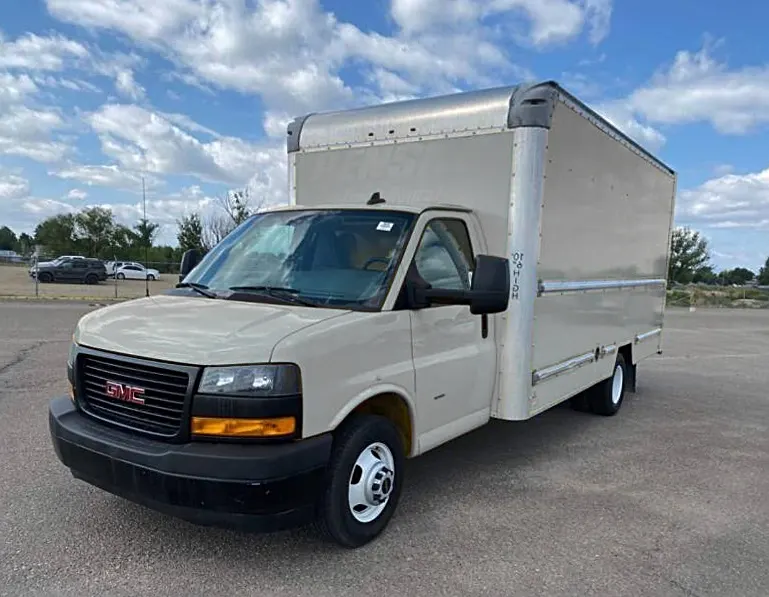
Interior Height: 86”
Another option for really tall folks is a box truck. They can vary in size, but most of your average 15’ box trucks are 86” tall inside (or 7’2”). Once fully converted they are probably just under 7 feet tall inside.
The nice thing about a box truck is that the interior is perfectly square. No pesky curves to build around. It makes converting them much easier than a van. Normal household furniture, like dressers, cabinets, and bookshelves will easily mount flush to the walls. They also can make great stealth campers, as long as you don’t add too many obvious mods to the exterior (windows, doors, vent fans, solar panels, etc).
But the negatives of box trucks are; awkward to drive, extra tall exterior, bad gas mileage, and no windows.
Conclusion | What Vans Can You Stand Up In?
The great news is that tall vans are probably here to stay. With Ford, RAM, and Nissan all introducing high-roof vans to compete with the Mercedes Sprinter, there are plenty of vans you can stand up in. In the past, it was really only fiberglass conversions and pop-top campervans that were tall enough to stand up in. Between all the new and used options, there are a wide variety of vans that offer standing heights.
I hope these height statistics help you figure out which vans you can stand up in. But remember to account for conversion materials that reduce the interior height. And also, it’s best to give yourself a little extra clearance, so you head isn’t constant scraping the ceiling.
Want to learn what else to consider when buying a van? Read How To Choose A Van For A Campervan Conversion.
Share “What Vans Can You Stand Up In?” On Pinterest!



How Much Did Our Camper Van Conversion Cost - tworoamingsouls
Monday 5th of December 2022
[…] goal was to get a van with less than 150,000 total miles. We also knew we wanted a van tall enough to stand in, so we wanted the van to have a high top, or cheap enough to install a hightop (which start around […]
High-Roof Versus Low-Roof Campervans | Pros & Cons - tworoamingsouls
Wednesday 6th of July 2022
[…] benefit of a high-roof campervan for most people is the ability to stand up inside. {Read: Which vans can you stand up in?} Full standing room makes a campervan much more comfortable to live out of, especially for […]